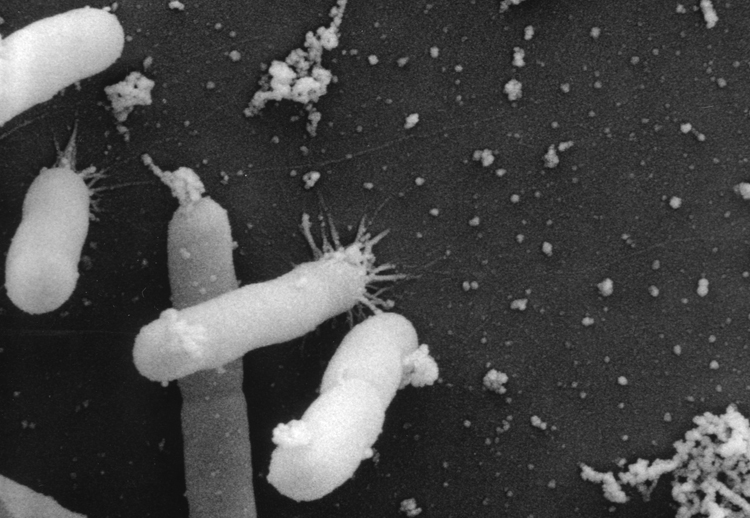Phillip M. Brannen1
Gerard Krewer2
Bob Boland3
Dan Horton4
C. J. Chang5海角官方首页 Plant Pathologist5
 Figure 1.
Figure 1. Electron microscope photograph of
Xylella fastidiosa bacteria (Pierce's disease of grape isolate) attached to a membrane surface. The bacteria and associated bacterial and plant-associated products will clog the xylem elements, the conductive tissues that transport water and nutrients from the roots, causing scorch symptoms and eventual plant death. Photo by H.C. Hoch, Cornell University;
Journal of Bacteriology 189:7507-7510.
Relative to total sales, blueberries are the number one fruit commodity in the state of Georgia, surpassing even peaches. Recently, a new disease has been identified in the Georgia blueberry production region. This disease has been named "bacterial leaf scorch," and it is caused by the bacterium Xylella fastidiosa (Figure 1).
Koch's postulates were recently utilized to confirm this new disease; the suspected disease-causing agent (bacterium) was isolated from a diseased plant, cultured, and reintroduced into a healthy plant in which subsequent disease symptoms developed that were similar to the original plant. For bacterial leaf scorch, Koch's postulates were conducted by Dr. C.J. Chang (University of Georgia) in the summer of 2006, and they were fulfilled in November 2006.
Through initial field surveys conducted in the summer of 2007, it was determined that this disease has the potential to become a major threat to blueberry production in Georgia and elsewhere, especially in the southern highbush blueberry varieties. Among these varieties, 'FL86- 19' (alias 'V1') has proven to be the most susceptible. However, 'Star' and other varieties are also showing substantial disease incidence and severity in several locations. At this early stage, little is known for sure about the epidemiology (means of dissemination and spread) of this disease, and the basic research to determine the means of spread and interaction within the south Georgia environment needs to be completed. In addition, research-based control methods need to be established for this disease. Current recommendations are based on information derived from other plant systems, such as wine grapes, and information needs to be developed specifically for blueberries.
Causal organism
The Xylella fastidiosa bacterium is pathogenic on numerous plant species. In addition, it is known to inhabit many host plants without causing disease symptoms; among these are various grasses and herbaceous weeds that are generally found throughout the blueberry production region of Georgia. Native blueberries also likely harbor the bacterium; therefore, there is generally a bacterial reservoir readily available for infection.
There are Xylella subspecies, of which X. fastidiosa subsp. fastidiosa and subsp. multiplex are major. The Xylella that causes Pierce's disease of grape falls in the fastidiosa subspecies, while the Xylella that causes phony peach falls in the multiplex subspecies. Both Pierce's disease and phony peach are examples of other major Xyllella-incited diseases that also occur in Georgia. The specific Xylella fastidiosa strains found in blueberry are generally unique recombinant multiplex strains. However, recent reports have indicated that some fastidiosa strains can also infect and cause symptoms on blueberry
As in other Xylella-incited diseases, it is assumed that the bacterium blocks xylem vessels, thereby preventing water and nutrient flow from the soil throughout the plant. This bacterium only survives in plant xylem or within the insects that vector it. In general, Xylella diseases are more prevalent in warmer environments; this is related in part to the fact that the insect vectors, primarily sharpshooters, survive better in warmer climates, but the bacterium also overwinters more successfully within host plants in warmer climates. Though it is speculation at this point, the increase in bacterial leaf scorch in Georgia may be at least partially related to warmer winters, which may have aided survival of vectors and the bacterium. South Georgia and Florida provide ideal environments for both the bacterium and the vectors to survive.
To date, the disease has been an obviously observed field problem of southern highbush blueberry varieties only. It is not known whether this disease is also causing chronic or acute problems in rabbiteye varieties, but the bacterium can in fact colonize rabbiteye plants. However, there is no doubt at this point that the disease is causing chronic and acute losses in southern highbush varieties
Disease cycle and causal conditions
Disease cycle and causal conditions The disease cycle of this bacterium in grape, peach, and plum is well known, and it is likely the same in blueberry. Infected hosts serve as reservoirs and overwintering sites of the bacterium. In the spring and early summer, insect vectors (sharpshooters and spittle bugs) transmit the bacterium by feeding on infected plant tissues and subsequently feeding on healthy plants. In other systems, the glassy-winged sharpshooter, Homalodisca vitripennis, is the most important vector, and 97 percent of the sharpshooters found in southern highbush blueberry plantings are glassy-winged sharpshooters (M. Tertuliano; personal communication). The glassy-winged sharpshooter can be found abundantly in south Georgia and Florida, where it is known to be the major vector of Xylella in peach and also prevents production of European wine grapes. Once the insect has acquired the bacterium, it is transmitted to a new plant as the insect injects the bacterium into the xylem (the conductive tissues that transmit water and nutrients from the roots to the other plant tissues) during feeding.
This bacterial species is unique in that it is limited to life in the plant xylem. Movement of the bacterium occurs throughout the plant xylem system, and movement to the roots is relatively rapid in blueberry—rendering pruning of symptomatic tissues ineffective. At some point, bacteria form colonies, and through a combination of tyloses, gumming, and bacterial exudate production, the xylem is clogged. In time, clogging of vessels reaches a point at which individual stems or whole plants will no longer be able to carry sufficient water and nutrients to support life. At this point